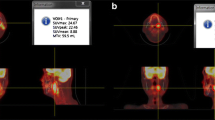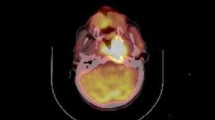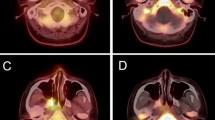Abstract
Purpose
To evaluate the use of 18F-FDG PET/CT as the principal investigation to assess tumour response, to determine the need for further surgery and to guide follow-up following radical chemoradiotherapy for stage III/IV oropharyngeal squamous cell carcinoma (OPSCC).
Methods
A retrospective analysis was undertaken in 146 patients treated at our centre with radical chemoradiotherapy for OPSCC and who had a PET/CT scan to assess response. According to the PET/CT findings, patients were divided into four groups and recommendations: (1) complete metabolic response (enter clinical follow-up); (2) low-level uptake only (follow-up PET/CT scan in 12 weeks); (3) residual uptake suspicious for residual disease (further investigation with or without neck dissection); and (4) new diagnosis of distant metastatic disease (palliative treatment options).
Results
The initial PET/CT scan was performed at a median of 12.4 weeks (range 4.3 – 21.7 weeks) following treatment. Overall sensitivity and specificity rates were 92.0 % (74.0 – 99.0 %) and 85 % (77.5 – 90.9 %). Of the 146 patients, 90 (62 %) had a complete response and had estimated 3-year overall and disease-free survival rates of 91.9 % (85.6 – 98.2 %) and 85.6 % (78.0 – 93.2 %), respectively, 17 (12 %) had residual low-level uptake only (with two having confirmed residual disease on subsequent PET/CT, both surgically salvaged), 30 (21 %) had suspicious residual uptake (12 proceeded to neck dissection; true positive rate at surgery 33 %). HPV-positive patients with reassuring PET/CT findings had an estimated 3-year progression-free survival rate of 91.7 % (85.2 – 98.2 %), compared with 66.2 % (41.5 – 90.9 %) of HPV-negative patients.
Conclusion
A strategy of using PET/CT results alongside clinical examination to help select patients for salvage surgery appears successful. Despite a complete response on the 12-week PET/CT scan, HPV-negative patients have a significant risk of disease relapse in the following 2 years and further studies to assess whether surveillance imaging in this group could improve outcomes are warranted.




Similar content being viewed by others
References
Ang KK, Harris J, Wheeler R, Weber R, Rosenthal DI, Nguyen-Tan PF, et al. Human papillomavirus and survival of patients with oropharyngeal cancer. N Engl J Med. 2010;363(1):24–35.
Martin RC, Fulham M, Shannon KF, Hughes C, Gao K, Milross C, et al. Accuracy of positron emission tomography in the evaluation of patients treated with chemoradiotherapy for mucosal head and neck cancer. Head Neck. 2009;31(2):244–50.
Adams G, Porceddu SV, Pryor DI, Panizza B, Foote M, Rowan A, et al. Outcomes after primary chemoradiotherapy for N3 (>6 cm) head and neck squamous cell carcinoma after an FDG-PET-guided neck management policy. Head Neck. 2014;36(8):1200–6.
Porceddu SV, Pryor DI, Burmeister E, Burmeister BH, Poulsen MG, Foote MC, et al. Results of a prospective study of positron emission tomography-directed management of residual nodal abnormalities in node-positive head and neck cancer after definitive radiotherapy with or without systemic therapy. Head Neck. 2011;33(12):1675–82.
Yao M, Smith RB, Hoffman HT, Funk GF, Lu MM, Menda Y, et al. Clinical significance of postradiotherapy [18F]-fluorodeoxyglucose positron emission tomography imaging in management of head-and-neck cancer – a long-term outcome report. Int J Radiat Oncol Biol Phys. 2009;74(1):9–14.
Machtay M, Moughan J, Trotti A, Garden AS, Weber RS, Cooper JS, et al. Factors associated with severe late toxicity after concurrent chemoradiation for locally advanced head and neck cancer: an RTOG analysis. J Clin Oncol. 2008;26(21):3582–9.
Donatelli-Lassig AA, Duffy SA, Fowler KE, Ronis DL, Chepeha DB, Terrell JE. The effect of neck dissection on quality of life after chemoradiation. Otolaryngol Head Neck Surg. 2008;139(4):511–8.
Mehanna HM, Wong WL, McConkey CC, Rahman JK, Robinson M, Hartley AGJ, et al. PET-NECK: A multi-centre, randomized, phase III, controlled trial (RCT) comparing PETCT guided active surveillance with planned neck dissection (ND) for locally advanced (N2/N3) nodal metastases (LANM) in patients with head and neck squamous cell cancer (HNSCC) treated with primary radical chemoradiotherapy (CRT). Proceedings of the American Society of Clinical Oncology Annual Meeting, 29 May – 2 June 2015, Chicago, USA; 2015.
Helliwell T, Woolgar J. Dataset for histopathology reporting of mucosal malignancies of the pharynx. London: Royal College of Pathologists; 2013.
Thavaraj S, Stokes A, Guerra E, Bible J, Halligan E, Long A, et al. Evaluation of human papillomavirus testing for squamous cell carcinoma of the tonsil in clinical practice. J Clin Pathol. 2011;64(4):308–12.
Guerrero Urbano MT, Clark CH, Kong C, Miles E, Dearnaley DP, Harrington KJ, et al. Target volume definition for head and neck intensity modulated radiotherapy: pre-clinical evaluation of PARSPORT trial guidelines. Clin Oncol (R Coll Radiol). 2007;19(8):604–13.
Ul-Hassan F, Simo R, Guerrero-Urbano T, Oakley R, Jeannon JP, Cook GJ. Can (18)F-FDG PET/CT reliably assess response to primary treatment of head and neck cancer? Clin Nucl Med. 2013;38(4):263–5.
May JT, Rao N, Sabater RD, Boutrid H, Caudell JJ, Merchant F, et al. Intensity-modulated radiation therapy as primary treatment for oropharyngeal squamous cell carcinoma. Head Neck. 2013;35(12):1796–800.
Setton J, Caria N, Romanyshyn J, Koutcher L, Wolden SL, Zelefsky MJ, et al. Intensity-modulated radiotherapy in the treatment of oropharyngeal cancer: an update of the Memorial Sloan-Kettering Cancer Center experience. Int J Radiat Oncol Biol Phys. 2012;82(1):291–8.
Clavel S, Nguyen DH, Fortin B, Despres P, Khaouam N, Donath D, et al. Simultaneous integrated boost using intensity-modulated radiotherapy compared with conventional radiotherapy in patients treated with concurrent carboplatin and 5-fluorouracil for locally advanced oropharyngeal carcinoma. Int J Radiat Oncol Biol Phys. 2012;82(2):582–9.
Mendenhall WM, Amdur RJ, Morris CG, Kirwan JM, Li JG. Intensity-modulated radiotherapy for oropharyngeal squamous cell carcinoma. Laryngoscope. 2010;120(11):2218–22.
Feng FY, Kim HM, Lyden TH, Haxer MJ, Worden FP, Feng M, et al. Intensity-modulated chemoradiotherapy aiming to reduce dysphagia in patients with oropharyngeal cancer: clinical and functional results. J Clin Oncol. 2010;28(16):2732–8.
Daly ME, Le QT, Maxim PG, Loo Jr BW, Kaplan MJ, Fischbein NJ, et al. Intensity-modulated radiotherapy in the treatment of oropharyngeal cancer: clinical outcomes and patterns of failure. Int J Radiat Oncol Biol Phys. 2010;76(5):1339–46.
Gupta T, Master Z, Kannan S, Agarwal JP, Ghsoh-Laskar S, Rangarajan V, et al. Diagnostic performance of post-treatment FDG PET or FDG PET/CT imaging in head and neck cancer: a systematic review and meta-analysis. Eur J Nucl Med Mol Imaging. 2011;38(11):2083–95.
Isles MG, McConkey C, Mehanna HM. A systematic review and meta-analysis of the role of positron emission tomography in the follow up of head and neck squamous cell carcinoma following radiotherapy or chemoradiotherapy. Clin Otolaryngol. 2008;33(3):210–22.
Slevin F, Subesinghe M, Ramasamy S, Sen M, Scarsbrook AF, Prestwich RJ. Assessment of outcomes with delayed (18)F-FDG PET-CT response assessment in head and neck squamous cell carcinoma. Br J Radiol. 2015;88(1052):20140592.
Abgral R, Querellou S, Potard G, Le Roux PY, Le Duc-Pennec A, Marianovski R, et al. Does 18F-FDG PET/CT improve the detection of posttreatment recurrence of head and neck squamous cell carcinoma in patients negative for disease on clinical follow-up? J Nucl Med. 2009;50(1):24–9.
Schlumpf MF, Haerle SK. The current role of imaging in head and neck cancer: a clinician’s perspective. Swiss Med Wkly. 2014;144:9.
Beswick DM, Gooding WE, Johnson JT, Branstetter BF. Temporal patterns of head and neck squamous cell carcinoma recurrence with positron-emission tomography/computed tomography monitoring. Laryngoscope. 2012;122(7):1512–7.
Kissun D, Magennis P, Lowe D, Brown JS, Vaughan ED, Rogers SN. Timing and presentation of recurrent oral and oropharyngeal squamous cell carcinoma and awareness in the outpatient clinic. Br J Oral Maxillofac Surg. 2006;44(5):371–6.
Kostakoglu L, Fardanesh R, Posner M, Som P, Rao S, Park E, et al. Early detection of recurrent disease by FDG-PET/CT leads to management changes in patients with squamous cell cancer of the head and neck. Oncologist. 2013;18(10):1108–17.
Ho AS, Tsao GJ, Chen FW, Shen TJ, Kaplan MJ, Colevas AD, et al. Impact of positron emission tomography/computed tomography surveillance at 12 and 24 months for detecting head and neck cancer recurrence. Cancer. 2013;119(7):1349–56.
Gregoire V, Lefebvre JL, Licitra L, Felip E; EHNS-ESMO-ESTRO Guidelines Working Group. Squamous cell carcinoma of the head and neck: EHNS-ESMO-ESTRO clinical practice guidelines for diagnosis, treatment and follow-up. Ann Oncol. 2010;21 Suppl 5:v184–6.
Fakhry C, Westra WH, Li S, Cmelak A, Ridge JA, Pinto H, et al. Improved survival of patients with human papillomavirus-positive head and neck squamous cell carcinoma in a prospective clinical trial. J Natl Cancer Inst. 2008;100(4):261–9.
Ragin CC, Taioli E. Survival of squamous cell carcinoma of the head and neck in relation to human papillomavirus infection: review and meta-analysis. Int J Cancer. 2007;121(8):1813–20.
Zafereo ME, Hanasono MM, Rosenthal DI, Sturgis EM, Lewin JS, Roberts DB, et al. The role of salvage surgery in patients with recurrent squamous cell carcinoma of the oropharynx. Cancer. 2009;115(24):5723–33.
Marcus C, Ciarallo A, Tahari AK, Mena E, Koch W, Wahl RL, et al. Head and neck PET/CT: therapy response interpretation criteria (Hopkins criteria) – interreader reliability, accuracy, and survival outcomes. J Nucl Med. 2014;55(9):1411–6.
Sjovall J, Bitzen U, Kjellen E, Nilsson P, Wahlberg P, Brun E. Qualitative interpretation of PET scans using a Likert scale to assess neck node response to radiotherapy in head and neck cancer. Eur J Nucl Med Mol Imaging. 2015. doi:10.1007/s00259-015-3194-3
Barrington SF, Mikhaeel NG, Kostakoglu L, Meignan M, Hutchings M, Mueller SP, et al. Role of imaging in the staging and response assessment of lymphoma: consensus of the International Conference on Malignant Lymphomas Imaging Working Group. J Clin Oncol. 2014;32(27):3048–58. doi:10.1200/jco.2013.53.5229.
Vainshtein JM, Spector ME, Stenmark MH, Bradford CR, Wolf GT, Worden FP, et al. Reliability of post-chemoradiotherapy F-18-FDG PET/CT for prediction of locoregional failure in human papillomavirus-associated oropharyngeal cancer. Oral Oncol. 2014;50(3):234–9.
Anderson CM, Chang T, Graham MM, Marquardt MD, Button A, Smith BJ, et al. Change of maximum standardized uptake value slope in dynamic triphasic [18F]-fluorodeoxyglucose positron emission tomography/computed tomography distinguishes malignancy from postradiation inflammation in head-and-neck squamous cell carcinoma: a prospective trial. Int J Radiat Oncol Biol Phys. 2015;91(3):472–9.
Author information
Authors and Affiliations
Corresponding author
Ethics declarations
Funding
No external funding was received.
Conflicts of interest
None.
Ethical approval
All procedures performed in studies involving human participants were in accordance with the ethical standards of the institutional and/or national research committee and with the principles of the 1964 Declaration of Helsinki and its later amendments or comparable ethical standards.
Informed consent
Informed consent was not required (retrospective study).
Rights and permissions
About this article
Cite this article
Bird, T., Barrington, S., Thavaraj, S. et al. 18F-FDG PET/CT to assess response and guide risk-stratified follow-up after chemoradiotherapy for oropharyngeal squamous cell carcinoma. Eur J Nucl Med Mol Imaging 43, 1239–1247 (2016). https://doi.org/10.1007/s00259-015-3290-4
Received:
Accepted:
Published:
Issue Date:
DOI: https://doi.org/10.1007/s00259-015-3290-4




